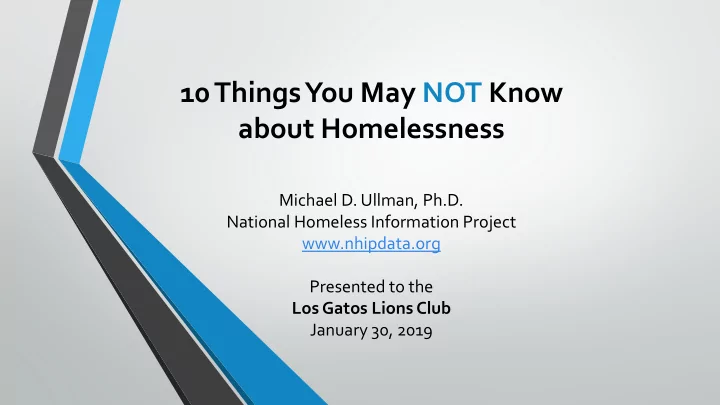

10 Things You May NOT Know about Homelessness Michael D. Ullman, Ph.D. National Homeless Information Project www.nhipdata.org Presented to the Los Gatos Lions Club January 30, 2019
Thing One: Homelessness has ALWAYS existed in the United States • Homelessness, especially idle men without a regular place to sleep, has always been present in the country. • Terms such as hobos, tramps, vagabonds, Bowery men, and bums. • Modern homelessness is different in two ways: 1) Impacted women and families with children, 2) Occurred during times of relative prosperity.
Thing Two: Reagan did not create homelessness • While large cuts in budget authority did occur from 1981 to 1985, federal housing expenditures continued to rise throughout 1980s. • Housing subsidies increased greatly in the 1980s as more vouchers were funded and increased subsidies for housing construction through the Low-Income Housing Tax Credit (LIHTC). • Despite proposing a bill to cut HUD funding by 10%, the Republican- controlled Congress passed and Trump signed a 2018-19 appropriations bill that increased public housing and homeless services funding.
Thing Three: Homeless agencies can HELP homeless people, but cannot end the flow of NEW people into homelessness • Most people who request or accept services can be re-housed. • Agencies cannot change societal forces that continue to create more people experiencing homelessness. • Freedoms and rights exist that prevent eliminating homelessness. Governments that succeeded in eliminating homelessness: 1) Nazi Germany 2) Stalin Russia/Soviet Union 3) Khmer Rouge
Thing Four: Most people who are homeless have a place to stay at night • The annual count of 550,000 homeless people on any given day includes people living long-term in emergency shelters and transitional apartments, many for longer than one year. • Approximately 170,000 (3 in 10) are found living on the streets. • Less than 5,000 families with children (16,000+ persons) are found living unsheltered in cars, tents, and other makeshift dwellings. The vast majority are located in warm or moderate weather climates (CA, FL, OR, HI and Pacific Territories)
Thing Five: Shelter People and Non-Shelter People are different Shelter Unsheltered This is why most people entering homeless shelters do NOT come from the streets - and why shelters do NOT reduce street homelessness
Thing Six: U.S. Housing Policy prevents families from helping family or friends with housing who may homeless or at-risk. • HUD rules and regulations prevent families in public housing or Section 8 voucher housing from letting other relatives or friends live doubled-up. • The average household size of public housing units is 2.2 persons – lower than the general U.S. household size of 2.7 persons.
Thing Seven: The primary factor in homelessness is NOT affordable housing • Most long-term homeless have little to no money, they can’t afford even $300 per month for housing. • Once people become homeless and are looking for their own place, it is very expensive to house them. • Homeless people are actually people who should be living in somebody’s else household (family, friends or institutional). Behaviors due to mental illness, substance abuse and related issues make this difficult.
Thing Eight: The primary factor in modern homelessness is the rise of single- adult households and fragmented family households • Single adults households have rise from 10% in 1950s to 30%+ • Single adults are 5 to 10 time more likely to become homeless • Ethnicities in the U.S. like Chinese, Filipino, Vietnamese, and others (possibly Greek) have much lower rates of homelessness.
Thing Nine: Problems and Barriers Remain • Cities continue to open up shelters (like SF and San Jose). • Confusion about data leads to misunderstanding of problem. • Anti-family regulations with government-funded housing leads to expensive solutions (one person = one apartment). • Many people believe drug addicts don’t deserve help • Many people still don’t understand serious mental illness
Thing Ten: Some Progress has been made • Fewer homeless veterans due to aging of Vietnam and Post- Vietnam era veterans. Close to $2 billion annually spent and much easily ability to get service-connected benefits. • Federal government funds only permanent housing, not shelters or transitional facilities, since they only increase homelessness. • Cities targeting some of the most expensive people living on the streets who use emergency services, jails, shelters, hospitals frequently.
THANK YOU Michael D. Ullman, Ph.D. Research and Non-Profit Consultant National Homeless Information Project Editor
Recommend
More recommend